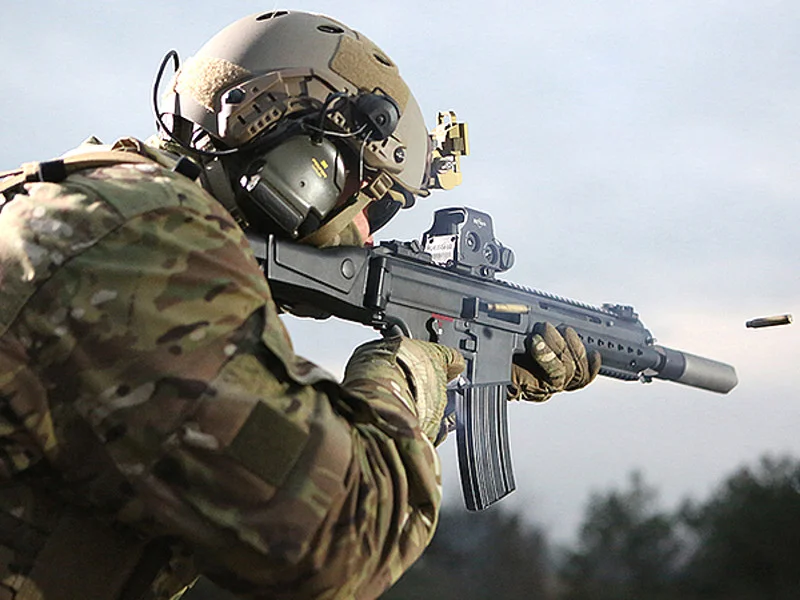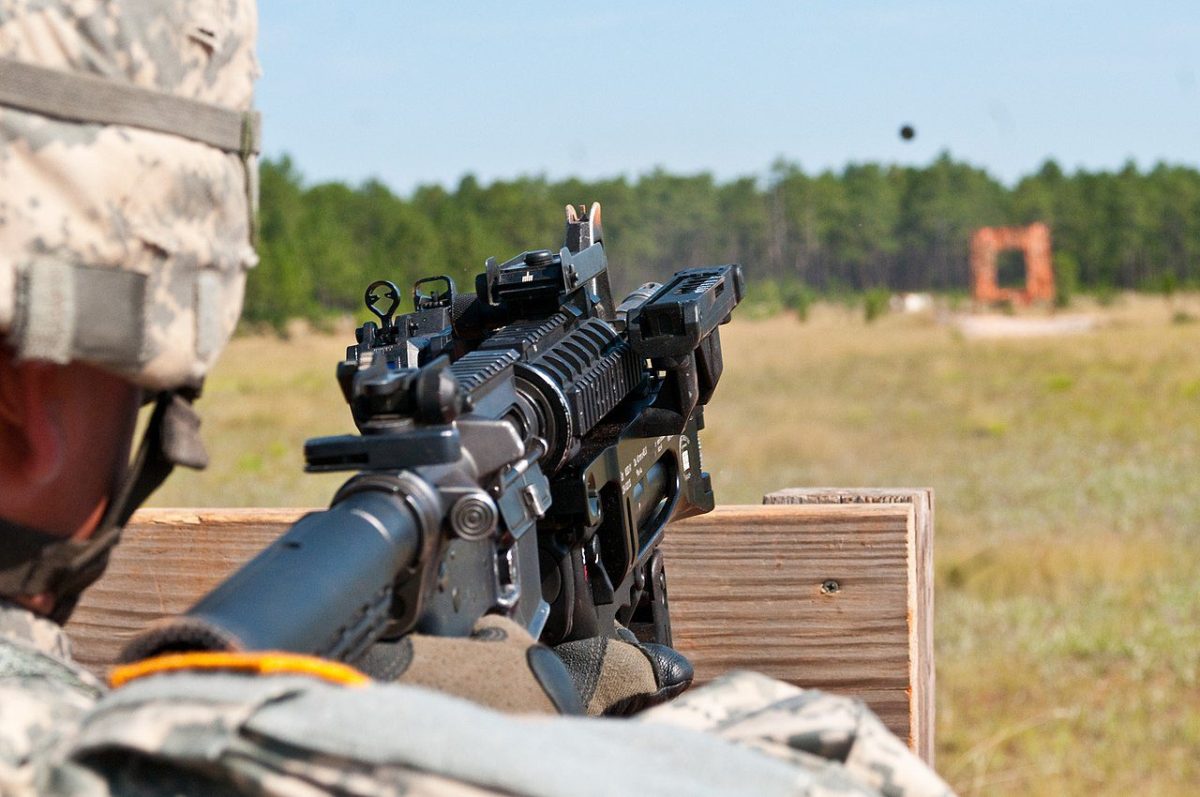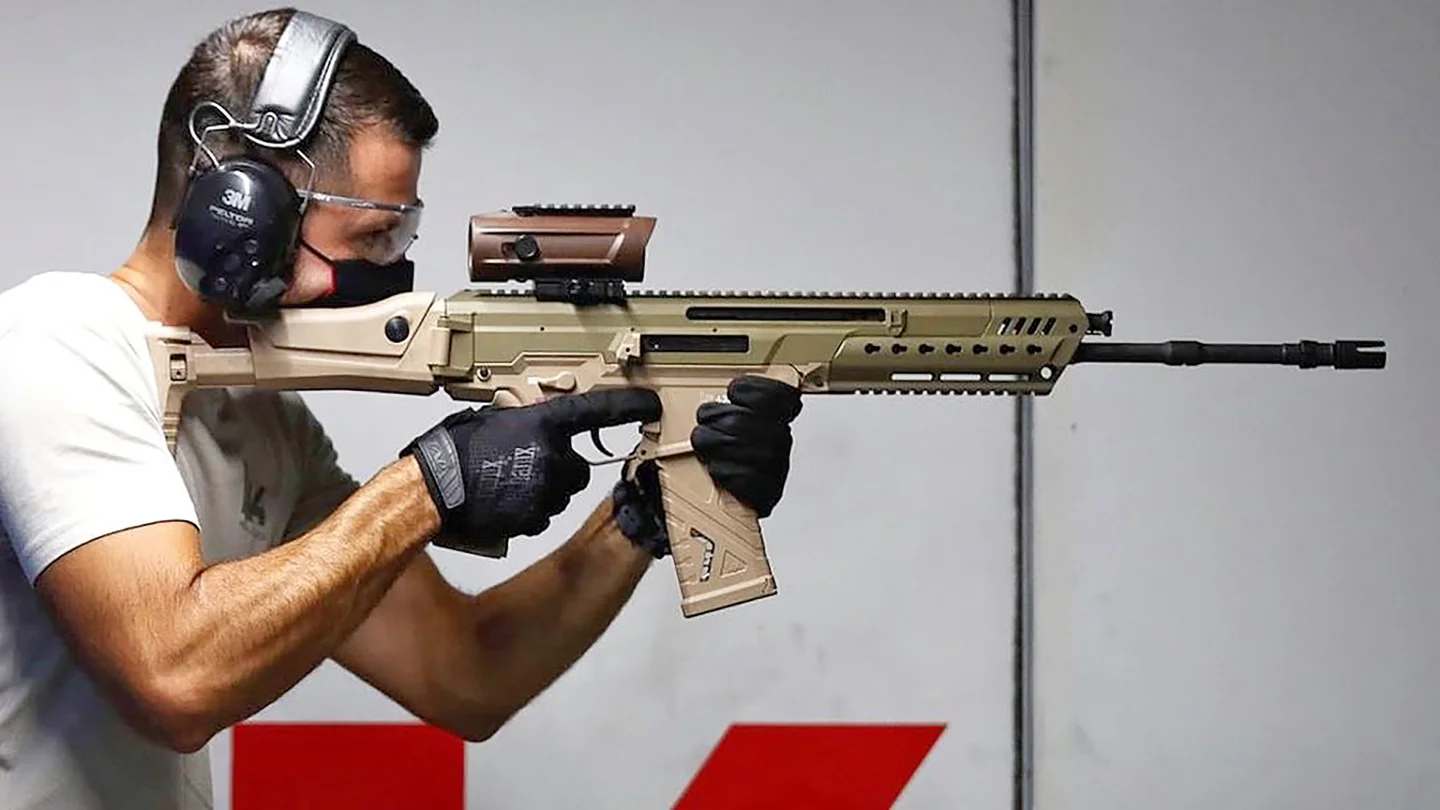For over 50 years, Heckler & Koch has been supplying the German armed forces with small arms. In 1959, H&K first provided the Bundeswehr with G3 battle rifles in NATO caliber 7.62mm x 51mm. These rifles were later updated with modularly designed parts and lighter materials, such as polymers, in 1997. The HK G36 assault rifle became known as one of the best in the world, but since 2010, there have been reports of its reliability issues.
It has been found that frequent burst firing can cause the barrel to overheat and soften the polymer, leading to the inaccurate shooting. This occurs when more than three or four rounds are fired quickly, particularly in hot climates. The German Ministry of Defense deemed this risk unacceptable, even though such situations are rare in operational conditions.

The service life of the G36 rifles is also soon to expire and cannot be upgraded to meet the current and future challenges faced by the infantry and special forces on the asymmetric battlefield. As a result, the Ministry has called for a tender for a new, more modern assault rifle to replace the G36. H&K has offered the HK416 rifle (A5 version), which is already the official rifle of the French army. Additionally, on October 12, 2017, the company announced that the HK416A7 (G95) version had won the tender to equip the German army’s special forces (Kommando Spezialkräfte – KSK).
The Bundeswehr’s arsenal already includes a range of small arms from H&K, including USP pistols (P8 and P12) and P30, automatic weapons (MP5 and MP7), rifles (G36, G38 (HK416A5) and HK417), machine guns (MG3 and MG4), the G28 sniper rifle, under-barrel rifle launchers (AG36, HK69A1), and the GMG automatic grenade launcher. In short, all small arms used by the German army are produced by H&K.
The view through the glass
However, in Oberndorf, it seems that Heckler & Koch did not expect so many competitors to be interested in the competition for a new assault rifle for the German armed forces. The most formidable opponent appears to be the consortium formed by Rheinmetall of Germany and Steyr Mannlicher of Austria, which will submit the modular RS556 assault rifle. Steyr Mannlicher’s partnership with Germany significantly increased its chances of victory, which it almost missed in 1994 when it introduced the AUG rifle.

Other contenders include C.G. Haenel/Caracal (CAR 816 rifle), Colt Canada/Diemaco (C8SFW), LWRCI (M6-G), Schmeisser (M4), IWI (X95), SIG Sauer (SIG MCX), Swiss Arms (SG 553), Thales (F90), Beretta (ARX-160), B&T (APC556), CZ (BREN 2), FN Herstal (FN SCAR-L), and FB Łucznik Radom (MSBS). In response to the strong competition and military complaints that the HK416 was too expensive, Heckler & Koch executives and engineers decided to design a new assault rifle.
Heckler & Koch first announced the existence of the HK433 rifle in a press release in early February 2017. They displayed the weapon at the Enforce Tac 2017 exhibition in Nuremberg. The only prototype was available for viewing through the exhibition glass, and representatives from Heckler & Koch have not revealed any details about its construction. They have only stated that the HK433 represents a step forward and uniquely combines certain tactical-technical features. They have also emphasized that, compared to the HK416, it is more reliable and has better ergonomics. The exhibition prototype was equipped with a Zeiss ZO 4 x 30 optical sight.

Two role models?
The rifle has a classic shape and is available in matte black or desert color. At first glance, it appears to be based on the proven SCAR model, the combat assault rifle produced by Fabrique Nationale of Herstal. On the other hand, it is quite similar to Magpul’s Masada, which is interesting because the Masada is, to some extent, inspired by the HKXM8 rifle, which Heckler & Koch competed with in the canceled tender for the US Army’s new rifle.
Overall, the new HK433 is a modular and compact rifle in the base caliber of 5.56mm x 45mm NATO. It is a weapon that combines the power and outstanding features of the G36 and HK416 assault rifles. Additional calibers, such as 7.62mm x 51mm NATO (HK231), .300 Blackout, and 7.62mm x 39mm (HK123), have also been designed, effectively creating a new family of assault rifles based on the HK433. The theoretical rate of fire of the HK433 is reduced to 700 rounds per minute, which is significantly less than other classic assault rifles.

For example, the American M4A1 fires at 950 rounds per minute, the HK416 at 850, and the G36 at 750. This should make it easier to handle during burst (automatic) fire, and the weapon creates a smaller and shorter flash when firing, making it harder to spot the shooter. Along with the bolt’s smooth movement, the barrel’s recoil is reduced, making it easier to handle when firing long bursts.
Integrated bolt guides in the upper housing ensure high performance and reliability. The bolt design is based on the G36 but has a firing pin safety system and self-lubricating slide elements.
The ejection port for cartridges is located only on the right side of the upper case, and behind it is a shell deflector, a protrusion that protects the face of a left-handed shooter from hot shells. The charging handle is primarily placed on the left side but can easily be moved to the right. This allows the shooter to keep the weapon aimed at the target without moving it and reduces strain on the shooter.
The ergonomically optimized positioning of the loading lever allows the shooter to keep the weapon aimed at the target while loading, even when lying down. The flat loading handle is also equipped with an integrated feature for the silent insertion of bullets into the barrel and remains in its position during firing. This increases the shooter’s safety in stressful situations and ensures safe handling and shooting possibilities.
Solutions with Picatinny rail
On the upper part of the upper housing, there is an integrated multi-purpose one-piece Picatinny rail under NATO STANAG 4694. The maximum length and low height allow the mounting of all available optoelectronic devices (reflex, holographic, telescopic, passive sights). The Picatinny rail is large enough to place two devices on it, an optical sight and a night sight in front of it, so that darkness is no longer an obstacle to action, and there is no need to change or adjust the sight because the existing one is used.
The molded front grip (foregrip) is thinner (Slim Line) and attached to the upper case with a pin. It can be removed without tools and allows the attachment of a sling for carrying the rifle. An additional Picatinny rail (MIL-STD-1913, and as an option also NATO STANAG 4694) is placed on the lower part of the front grip (at 6 o’clock). It is used for mounting additional equipment, such as the HK269 or GLM 40mm under-barrel grenade launcher, laser target designator, front grip handle, tactical flashlight, or legs. On both sides of the front grip (at 3 and 9 o’clock), there are modular HKey mounting slots, which also serve to mount additional rails and tactical aids.
The lower housing is replaceable, which defines the desired operating concept of the rifle and reduces the need for retraining the shooter. Users can choose between the G36 and HK416/AR-15 operating concepts depending on their training. All control elements (commands) are installed on both sides (fire selector, bolt catch, and magazine release), are designed and placed symmetrically, and can be configured according to requirements. The fire selector is located above the grip, is bilateral, and is easy to operate. Pictograms or icons indicate the firing mode (single shot, burst, automatic). The fire selector lever rotates from one firing mode to another by 45 degrees.

The magazine release can be done using a lever in front of the trigger guard, as in the G36. There is a possibility of installing a magazine inserter that will accept highly reliable metal magazines (Highly Reliable Magazine – HRM). The release is done by pressing a button on the lower case as on the HK416/M4. Replacement solutions expand the functional scope of the HK433, so it is envisaged that the trigger can be individually adjusted, i.e., replaced with a competition trigger, or the entire trigger mechanism can be replaced with a new one. According to factory specifications, the trigger pull force is 2.4 kg, with a very short reset, which allows the next round to be fired quickly in semi-automatic mode.
Silencer option
The pistol grip is similar to the M16/M4 rifles, with checkered relief grooves on both sides. The foregrip grips and rear insert are interchangeable and are very similar to those on the HK P30 and SFP/VP series pistols. This solution enables optimal adaptation of the grip to different hand sizes.
The barrel is cold-forged from high-quality steel, and the interior is hard-chromed to protect against corrosion, making the weapon easier to clean and maintain. H&K also uses additional optimization measures to extend the service life of the barrels. The barrels are factory equipped with a new generation gas piston that can be adjusted for use with a silencer without tools. An operator must turn the adjustable gas regulator to the “S” (sound suppressor) position if a silencer is used.
Shooting with a silencer causes a greater load on the rifle and contributes to its faster wear and tear. An improperly adjusted gas regulator can compromise the functionality of the rifle. Shooting in burst fire mode can damage the silencer. At the mouth of the barrel, there is a flame arrestor, which also serves as a gas brake. In addition, an adapter for the front sight and bayonet holder can be installed.
Over the past few years, manufacturers of assault rifles have increasingly emphasized the modularity of their weapons as a key feature. The HK433 rifle, for example, is designed with easily replaceable sub-assemblies that can be changed quickly and easily, even in the heat of combat. This is especially useful for special forces operators, who may frequently use a lot of ammunition during training and need to replace barrels. With the HK433, they can do this themselves in just a few minutes without needing specialized tools or sending the rifle away for maintenance.
The HK433 is also modular in other ways, offering the option to choose between six different barrel lengths. This allows the weapon to be customized for different scenarios, such as personal defense, close combat, or long-range shooting. The barrel lengths range from 280 mm (11 inches) to 503 mm (20 inches), with the standard length being 368 mm. This length is a good balance between ballistics performance and ease of handling, resulting in the rifle’s total weight of 3.4 kg. The HK433 is effective at distances of up to 500 meters, depending on the length of the barrel.
One feature that sets the HK433 apart from other assault rifles is its ergonomic stock, which is foldable and adjustable in length and height. Made of high-strength polymer, the stock can be adjusted within five positions (84 mm) to accommodate the shooter’s body size and protective gear. It also has a large flat, convex, or concave shock absorber at the rear to provide comfort in the shooting position. The stock can only be folded to the right, which makes the weapon more compact for transport. The trigger is still accessible even in the folded position, and the shell ejection opening is not covered, allowing the weapon to function fully in an emergency. This is not a typical feature of M-16/M-4 type rifles, which have fixed stocks with only the option to adjust for length.
Guarantees from the company
The HK433 assault rifle from Heckler & Koch is designed with special materials and surface treatment combinations to ensure minimal maintenance and an above-average lifespan, even in extreme conditions. The rifle has camouflage and infrared-absorbing coatings that reduce its visibility to night-vision devices. According to the manufacturer, the HK433 guarantees unlimited functionality and security in all combat and climatic conditions, focusing on handling safety. It is drop-resistant according to NATO’s AC 225/D14 standards and has a high level of finishing and adaptive ergonomics.
H&K also considered the complex challenges that infantry and special forces face when designing the HK433. The company targets the domestic market with the rifle as a strong contender for the new German Rifle System (System Sturmgewehr Bundeswehr). The HK433 is characterized by its ability to collect data on the weapon and the number of firings, which facilitates maintenance and troubleshooting. It is also known for its high level of finishing and adaptive ergonomics, which are the result of proven technology, making it a top candidate for the new rifle of the German army.
Shot counter
The HK433 assault rifle from Heckler & Koch can be equipped with a shot counter, similar to the FN SmartCore system used in SCAR rifles. This shot counter is designed to be maintenance-free and tamper-proof, with sophisticated electronics that simplify preventive maintenance, provide condition assessment, and offer valuable feedback. It acts as a digital logbook, collecting data such as the number of firings (including practice, live, and dry rounds), the type of weapon, serial number, year of manufacture, deployment information, responsible party, and working condition.
This data can be automatically or manually collected and wirelessly transferred to a computer or tablet, allowing for efficient weapons management and increased operational availability while reducing costs. The shot counter is primarily intended for military and security forces and is a key part of the H&K company’s commitment to smart weapons management.
HK269 under-barrel grenade launcher
The HK269 under-barrel grenade launcher is a 40mm x 46mm caliber weapon designed for use with the HK433 rifle. It is an updated version of the GLM/M320A1 under-barrel grenade launcher and can be used with instant, cumulative, smoke, lighting, and special-purpose grenades, including shock, flash, and tear gas. One unique feature of the HK269 is its modular design, which allows it to be mounted on a rifle or used as a handheld launcher with a telescopic stock and front handle.
Users can open the launcher on both sides for easy use with either hand. It is also smaller and lighter than its predecessor and features new aiming systems tailored to the ballistics of firing shells from a shorter barrel. The HK269 is equipped with a mechanical, day/night sight, and a laser rangefinder, making it easier to aim and use in low-light conditions.
The launcher weighs 1,270 kg, has a length of 285 mm (with a barrel length of 215 mm), and has an effective range of 150 m for individual targets, 350 m for groups, and 400 m for the maximum range, depending on the type of grenade used. The theoretical rate of fire is 18 rounds per minute, with a practical rate of five to seven shells per minute. It is mounted on the rifle using a Picatinny rail and can use an ammunition tank according to the NATO STANAG 4179 blueprint, as well as tanks from other systems such as the G36 or HK416. The rifle can also use standard 30-round magazines compatible with commercial AR-15 platforms, including an improved steel magazine or a new Gen3 polymer magazine.
Technical specifications
| Country of origin: | Germany |
| Manufacturer: | Heckler & Koch GmbH |
| Caliber: | 5.56 mm x 45 |
| Operating principle: | Gas-operated |
| Magazine capacity: | 30 rounds |
| Modes of fire: | Single fire/full auto |
| Rate of fire: | approx. 700/min |
| Buttstock: | R, FO |
| Dimensions | |
| Length min./max.: | approx. 577/843 mm |
| Width: | approx. 81.0 mm |
| Height: | approx. 195.0 mm |
| Barrel length: | approx. 280 mm |
| Weight | |
| Weapon: | approx. 3,250 g |
| Magazine: | approx. 160 g |

